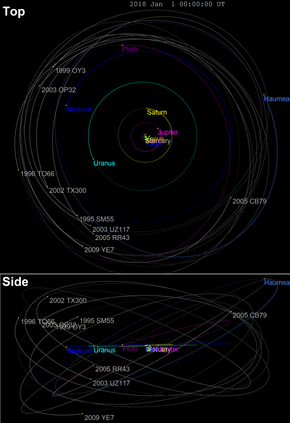|
(120178) 2003 OP32
(120178) 2003 OP32, also written as (120178) 2003 OP32, is a trans-Neptunian object (TNO) that resides in the Kuiper belt. It was discovered on July 26, 2003 by Michael E. Brown, Chad Trujillo and David L. Rabinowitz at Palomar Mountain in California. OriginBased on their common pattern of infrared water-ice absorption and the clustering of their orbital elements,[9] the other KBOs 1995 SM55, (19308) 1996 TO66, (55636) 2002 TX300 and (145453) 2005 RR43, among others, appear to be collisional fragments broken off the dwarf planet Haumea. The neutral color of the spectrum of these objects in the visible range evidences a lack of complex organics on the surface of these bodies that has been studied in detail for the surface of Haumea.[10] References
External links
|
||||||||||||||||||||||||||||||||||||||||||||||||||||||||||||||||||

